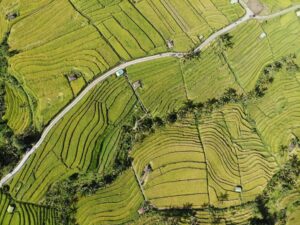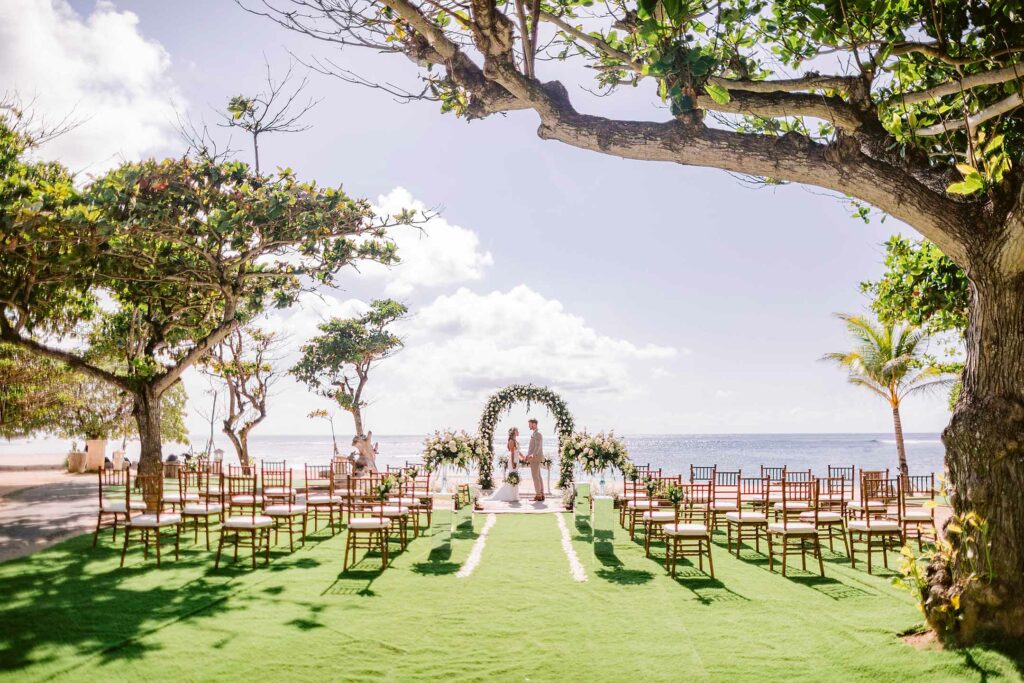While many people dream of Bali under a sunny sky, the island has a deep beauty. This secret is often reserved for the experienced traveler. This secret is the “Green Season.” When the calendar turns to Bali in November, the first nourishing rains arrive. Then the island transforms beautifully. It is a time when the entire landscape relaxes. It bursts forth in a thousand shades of deep green.
Forget what people may say about the “rainy season.” We invite you to discover this. November is the start of the Green Season. It might just be the most magical time of all to experience the Island of the Gods.
The Arrival of the Rains: A Blessing, Not a Burden
The first rains of November are not a sign to stay away. They are a blessing (berkah). The rain washes the island clean. It also clears the air. The landscape awakens from its dry-season rest. The rain in Bali is rarely an all-day event. Instead, it often comes as short, intense afternoon downpours. These showers are very refreshing.
This is a time for cozy relaxation. Imagine listening to the gentle drumming of rain on the roof. You are comfortable on your private balcony. Then the clouds part. They reveal a stunning, golden sunset. The air feels fresh and clean afterwards. It is filled with the beautiful, earthy scent of rain.
The Island in Emerald: A Feast for the Eyes
In Bali in November, the color palette shifts. It changes from gold to a brilliant emerald. It is a wonderful visual experience. These sights are at their absolute best during the Green Season:

The Rice Terraces
The Rice Terraces: The famous, sculpted rice paddies are at their most intense. This is true in places like Tegalalang and Jatiluwih. The new rice shoots create a carpet of neon green that glows. You can often see them shrouded in a beautiful morning mist.
The Waterfalls: The rains feed Bali’s waterfalls. They change from gentle trickles into powerful, thundering cascades. This is the time of year to see their full, majestic power. The jungles around them seem to be fully alive.
The Jungles & Gardens: Every leaf in Bali’s lush jungles looks freshly polished. The colors are deeper, and the flowers are brighter. The entire island feels full of life.
A Sensory Experience: The Feeling of a Reawakened Bali
A November visit is more than just a visual experience. It is a complete sensory one. The entire island feels more alive.
- The Tranquility: The crowds are smaller during the shoulder season. Therefore, you can often experience Bali’s temples and natural spots in peace. This allows for a more personal connection.
- The Atmosphere: The temperatures are often slightly cooler. They are more comfortable than in the peak dry season. This makes it perfect for exploration.
- The Sounds: The Green Season has its own beautiful music. You can hear the powerful rush of a full waterfall. You can hear the gentle chorus of frogs in the evening. There is also the calming rhythm of rain. These sounds create a perfect soundtrack for relaxation.
Adventures in the Rain: Fun Beyond the Sunshine
The Green Season doesn’t mean you have to stay indoors. For the adventurous traveler, a little rain simply adds to the excitement of Bali’s outdoor activities. Here are a few experiences that are amazing in November, rain or shine.
1. Go on a Thrilling ATV Ride: Riding an All-Terrain Vehicle (ATV) through Bali’s jungle is always fun. The Green Season makes it even better. The rain makes the tracks muddy and slick. This adds a thrilling splash of adventure to your ride. Imagine powering through jungle trails and splashing through puddles. You will get covered in the mud of the real Bali. It is a guaranteed rush.
2. Cozy Up with Lakeside Glamping: Glamping (glamorous camping) on the shores of one of Bali’s lakes is magical in November. Try Lake Batur or Lake Buyan. The cool, misty mountain air and the gentle sound of rain on your tent create an incredibly cozy escape. You can wake up to the sight of the peaceful lake shrouded in mist. You will feel completely connected to nature while still being comfortable. It is a truly romantic adventure.
3. Conquer the Rapids with White-Water Rafting: Bali’s rivers, like the Ayung River near Ubud, are at their absolute best during the Green Season. The rains raise the water levels. This makes the rapids faster, bigger, and more exciting for a thrilling adventure. Furthermore, the jungle scenery along the riverbanks is at its most lush and beautiful.
-
- Important Safety Note: Rafting during a light shower can be a fantastic experience. However, do not go rafting during or immediately after very heavy rainfall. Heavy downpours can cause the river levels to rise too quickly. This creates dangerous conditions. Always choose a certified rafting operator. Their professional guides constantly monitor the weather and river conditions. They will be the best judge of safety. They will cancel or postpone a trip if there is any risk. We always put your safety first.
Embracing the Green Season
A day trip into the island’s green heart is a must during this time of year. Our Concierge team can help you craft the perfect “Green Season” tour. They can arrange a private car to take you to the most spectacular waterfalls and viewpoints. Afterwards, you can return to the comfortable peace of Nusa Dua. You will have experienced the island at its most alive.


 The Merusaka Advantage:
The Merusaka Advantage: For the curious traveler, a trip to the highlands during this time is a wonderful sensory experience. As your friendly hosts at Merusaka, we invite you to journey with us beyond the coast. Let’s discover the bountiful heart of Bali.
For the curious traveler, a trip to the highlands during this time is a wonderful sensory experience. As your friendly hosts at Merusaka, we invite you to journey with us beyond the coast. Let’s discover the bountiful heart of Bali. Bali’s coffee is famous around the world. We are talking about the Arabica from the Kintamani region. People know it for its smooth, rich flavor and low acidity. The harvest season is the perfect time to discover its fascinating journey. You can see how this beloved bean goes from a cherry to a cup.
Bali’s coffee is famous around the world. We are talking about the Arabica from the Kintamani region. People know it for its smooth, rich flavor and low acidity. The harvest season is the perfect time to discover its fascinating journey. You can see how this beloved bean goes from a cherry to a cup.

